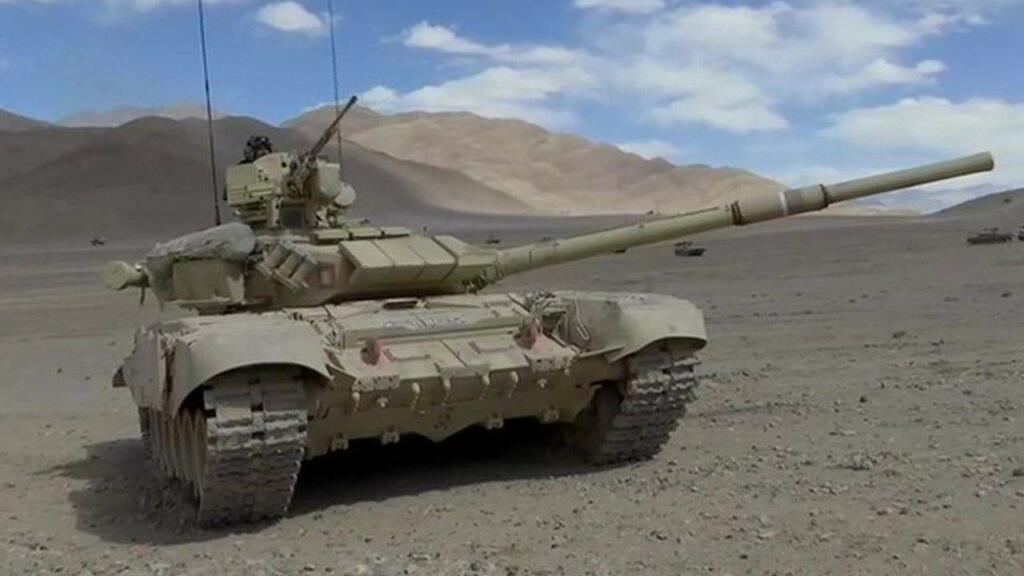It has been more than a year since the Indian Army started deploying a large number of tanks in Eastern Ladakh along the Indo-Tibetan border. Over time, the Indian armoured regiments have trained and evolved their standard operating procedures to use these mighty machines more effectively at altitudes ranging from 14,000 feet to 17,000 feet above sea level – which are common in the region. So, Indian tanks and officers handling them are a class apart when it comes to high altitude warfare.
Last year, with the beginning of Operation Snow Leopard, which was aimed at countering China’s wimp-like troops in Eastern Ladakh, the Indian Army brought the T-90 Bhishma and T-72 Ajay tanks along with the BMP series Infantry Combat Vehicles from the deserts and plains to these high-altitude locations.
Recently a team from the news agency ANI witnessed the tank manoeuvres carried out by an Indian Army tank regiment while practising attack operations in high-altitude areas at a location barely 40 km from the Tibet border. Last year, the Indian Army had even created a huge infrastructure for supporting its tank operations including tank shelters, which will help with the upkeep and service of the machines during winters.
“We have already spent a year in the Eastern Ladakh at these heights experiencing temperatures up to -45 degrees. We have evolved our SOPs to operate the tanks in these temperatures and harsh terrain,” an Army official told ANI.
Therefore, if a high-altitude warfare is to take place, India has a decisive strategic advantage over China. And the Indian Army’s recent tank exercises in the region have sent a resounding message to the PLA. China has understood that India is prepared for war and that its PLA troops are no match for the Indian forces.
Both sides continue to maintain troops in large numbers along the Line of Actual Control, despite disengagement at few locations like Pangong Lake and Gogra heights. The Indian Army has continued to strengthen its operations in these areas with tanks and ICVs to tackle any threat or challenge at these heights.
China has realised that India is not playing games and is dead serious about its territorial sovereignty. India is no longer trying to remain in the good books of China. In a historic shift in June, at least 50,000 Indian troops were redirected to the northern border with China, taking India’s total troop tally in the region to well over 2,00,000 — signalling an increase of more than 40 per cent from last year.
After the Chinese little emperors, who the CCP likes to refer to as PLA troops moved to locations such as the Pangong Tso Lake and the Galwan valley in Eastern Ladakh early last year, the Indian Army had started deploying men and machines in very large numbers and had also employed resolute actions in the area to deter the Chinese from behaving aggressively.
Only recently, as reported by TFI, the Indian army had conveyed to the Chinese that it is well equipped and fully prepared to deploy its troops to the Kailash range with the aim of rattling China and dominating its crucial infrastructure. China’s Western Highway will be well within the Indian Army’s reach if India decides to augment its strengths at the Kailash range once again. India has made it clear to China that if its patrolling rights are not restored in Depsang and if the Chinese do not withdraw from the area, the Indian Army will deploy its troops to the Kailash range.
Read more: Indian forces will surround Chinese troops if China does not cede Depsang
While the Indian troops are well acclimatised for the extremely cold and inhospitable Winters of Ladakh, the Chinese People’s Liberation Army (PLA) becomes virtually defunct during the winter months. They are no match for Indian troops who know the Himalayan ranges like the back of their hand. While the LAC in Eastern Ladakh remains a daunting location, it is pertinent to note that Indian soldiers have held positions at even greater heights on the Siachen glacier – the world’s highest battlefield and have survived the worse off winters there. As such, India is well prepared to teach China a wholesome lesson whenever the Communist nation wants.
